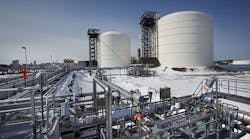In a market where delays and outages are never far off, the near-flawless start of U.S. liquefied natural gas plants will have European energy traders and executives abuzz when they meet this week at Flame.
How that extra gas will add to a global glut as Russia, the world’s largest exporter of the fuel, seeks to pump record volumes to the region will likely dominate talks among the 600 or so delegates meeting for Europe’s biggest gas conference in Amsterdam. Supply issues, the outlook for demand and pricing are also on the agenda.
U.S. LNG: Just the Start
Since Cheniere Energy Inc. started exports from its Sabine Pass facility in Louisiana in February last year, three of as many as six planned production units have fired up and shipped more than 100 cargoes. Unlike at recent plants in Australia and Angola, there were no major setbacks.
More plants will liquefy gas from the U.S. shale boom in 2017-2018. The nation’s LNG exports may reach 65 million tons by 2020, more than China and South Korea imported last year, according to Citigroup Inc.
“The markets may have been surprised by the effectiveness in implementation that Sabine Pass showed,” said Zach Allen, president of energy consultant Pan Eurasian Enterprises. “You may hear a good deal of bluster about the U.S. impact on the global markets.”
The Battle for Europe
U.S. LNG has already reached southern Europe and will next month arrive in Poland, the first delivery to a former Soviet Bloc country. European LNG supply is set to increase this year, spurring Russia’s Gazprom PJSC to compete, according to a Citigroup report last month.
That also applies to the rest of Europe’s main foreign suppliers -- Norway, Algeria and Qatar -- faced with emerging exporters from U.S. LNG to pipeline gas from the Caspian region, according to Bloomberg Intelligence.
Norway, Europe’s second-biggest source of gas, will likely produce more this summer compared with a year earlier because of a lighter maintenance schedule, increased production capacity and positive price spreads, Bloomberg New Energy Finance said in a report last month.
Rough and Groningen
Centrica Plc’s announcement last month that Britain’s Rough storage site will be shut until at least next summer and a Dutch decision to further tighten extraction caps at Groningen, Europe’s biggest field, have brought domestic supply to the fore. Traders are likely to favor mainland storage sites over the summer injection season, and in April moved the most fuel via a pipeline from Britain to Belgium for that month in more than five years.
Demand
With LNG supply expected to exceed demand into the next decade, exporters are targeting emerging markets in Asia, Africa and the Middle East that often turn to imports via floating storage and regasification units, faster and cheaper options than land-based terminals. FSRUs will be among the most-talked about topics as “a major driver of LNG demand in an oversupplied global gas market,” BI analyst Elchin Mammadov said.
“The growth prospects in the global market really depend on unfamiliar markets that are emerging and are not so transparent,” Allen said. “I would expect a lot of discussion about those. One big ‘dark horse’ at the moment might be the prospects for LNG into the Philippines.”
For Europe, the question is whether a recovery in demand will be sustained, Mammadov said. European consumption rose for a second year, advancing 7% in 2016 amid the fuel’s increasing popularity to generate power use for gas to generate power and colder winters.
Oil-linked pricing
With Gazprom executives scheduled to speak at Flame, the subject of linking gas prices to oil in long-term contracts will also be high on the agenda.
Pressed by buyers seeking changes to how gas is sold within Europe, the exporter has in recent years moved away from indexing its long-term contracts to oil with a time delay of six to nine months. Spot and hybrid pricing, a combination of spot and oil linkage, cover a little more than 50 percent of total volumes sold, Gazprom Deputy CEO Alexander Medvedev said last month.
By Anna Shiryaevskaya



